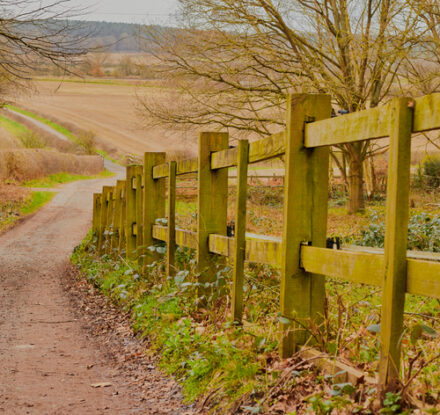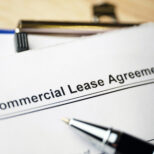
Avoiding problems with easements on commercial land
16th August 2023 by Claire Taylor
If a neighbouring landowner uses part of your land for something, such as access or drainage, it is likely that they will have a formal right known as an easement. This could restrict your ability to redevelop or extend existing buildings on your land. Easements are fertile ground for disputes, because it is not always clear how far they extend, exactly what they may be used for and what counts as an interference with them. To avoid problems, make sure you get expert legal advice before allowing any new rights over your land or doing anything which might affect a neighbour’s existing rights.
‘Commercial property in the UK is often developed in clusters, so neighbours rely on being able to cross each other’s land where necessary,’ says Claire Taylor, Partner in Laceys Commercial Property team. ‘What sounds perfectly straightforward in principle can end up in a costly dispute if you have not thought about all the detail in advance.’ This is why it is so important to get your solicitor involved as early as you can.
Common types of easement
An easement is a right for one landowner to use a part of another owner’s land in a way that would otherwise be trespassing. The right must benefit the user’s own land in some way. The most common types of easement are rights of way, rights of drainage, and rights of light; and it is easy to see how these benefit the land of the user. There are many other types of easement and, in addition, utility providers like electricity and gas companies may claim statutory easements. The law on these is a bit different so, in this article, we look only at common law easements between private landowners.
The extent of an easement
The most important thing to understand about easements affecting your land is exactly what your neighbour is allowed to do and which areas of your land they are allowed to use. For example, a right of way may be for pedestrian access only, or it may allow access on foot or with vehicles. The key point is that the user may do only what is permitted and nothing more, and if a dispute arises a court may have to decide what that is.
How easements are created
An easement may be expressly granted by deed, in which case it is crucial to make sure that it is described clearly and with all the relevant detail. Easements can also be acquired by a long period of use, for example where someone establishes a right of way over land by repeatedly using it, without having express permission to do so. If there is a dispute over the extent of this type of easement, the starting point will be how it has actually been used and what your land and your neighbour’s were used for when the easement first began.
The impact on you and your land
If someone has an easement over your land, you must not do anything which interferes with it in a way that makes it substantially less convenient to use. What that means in practice will depend on the facts, but it can become an obstacle if you want to redevelop or extend buildings on your land. For example, you do not have an automatic right to change the route of a right of way unless this was set out in writing when the easement was granted. Similarly, you may not be able to erect fences or boundary walls if they make it less convenient for your neighbour to use an access route, nor can you reduce the area over which the right may be exercised if that makes it more difficult to use.
The issue of security gates often comes up with rights of way. You may be able to install gates, but your neighbour must be able to open them easily. Courts have decided that a code or electronic fob to open a gate is less convenient than, say, a push-button mechanism. While one gate might be acceptable, installing several gates over a short distance is not.
If your neighbour has a right of drainage through pipes on your land, you must not build over them in a way that makes repair and maintenance difficult. Written deeds of easement usually deal with who will keep roads or pipes in good repair and how the cost will be split. If this is not clearly set out, neither of you is obliged to repair but either of you can if you wish. As landowner, you cannot assume that you will be able to recover repair costs from your neighbour if this is not clear in writing. Even more important is the fact that they will have the right to come onto your land to make repairs and you must not do anything that would prevent this.
If you buy land which is subject to an easement and your seller had already done something to interfere with it, you might be treated as ‘adopting’ their breach and be held liable for it yourself. So, as well as inspecting carefully, make sure your solicitor reviews and explains the extent of any existing easements.
Rights of light can stop planned developments in their tracks if a new or extended building would block light to a neighbour’s window. The law on rights of light is complex, so you should speak to an expert solicitor about any concerns as soon as you can. Issues can often be resolved by negotiation – this is true for all types of easement, not just light – but the courts will penalise landowners who do not engage with neighbours in a constructive way, and you could face an injunction.
Be vigilant
As a landowner, it pays to keep a close eye on the way anyone is using their rights over your land. You should look out for anything which might give rise to a new right, for example if you notice a new path being trodden or a new window on a neighbour’s land which receives light via your land. It is possible to stop things like this turning into a formal easement if you act promptly and your solicitor can advise you about what to do. To block a new right of way, this could include physically preventing access or erecting signs stating that the land is private and may be used only by tenants or customers. Blocking a right of light requires more complex legal processes, which your solicitor will be able to explain.
Where your land is already subject to easements, watch out for any change in the way the right or the neighbouring land is being used. The court decisions in this area are very dependent on their facts, so they can be conflicting, but the principle is that if the use changes in a way which puts a greater burden on your land than originally intended, you may be able to stop it. In particular, if the use of the neighbouring land changes completely, your neighbour may no longer be able to rely on an easement.
How we can help
Easements may get in the way of your plans to redevelop your land. A dispute with your neighbour about their rights could make life very difficult and end up in expensive court proceedings. Our expert commercial property lawyers are here to help you deal with any easement problems as constructively as possible. For further information, please contact Claire Taylor on 01202 377817 or email c.taylor@laceyssolicitors.co.uk
This article is for general information only and does not constitute legal or professional advice. Please note that the law may have changed since this article was published.



